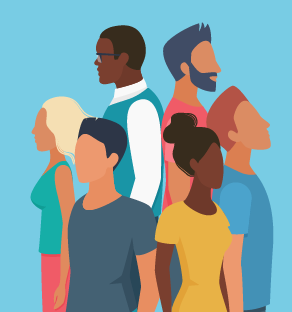How do you stand out in a crowd? Specifically, if you’re an artist or performer, how do you stand out in a sea of other creators and influencers? The answer comes down to harnessing your individuality and authenticity.
Because of readily available technology and social media platforms, it’s easier than ever for people to share their ideas with the world. These spaces also present an opportunity for us to find unending inspiration and access to new concepts and ways of working. Connecting with other artists that you enjoy is great, and integral to being a part of a creative community. But sometimes we might wonder where the distinction between our work and theirs is drawn. Being constantly bombarded with information, news, and expression can blur the lines between what we authentically feel and what’s being shared with us. By practicing some of the methods below we can continue to balance-check ourselves and our work to make sure that we’re producing content that is unique and meaningful.
Honing Your Message/Finding Your Voice & Style
No one is the same as you. No one has the same combination of feelings, ideas, experiences, and perceptions of the world. But remember that we never stop learning and our vision of the world and ourselves is constantly shifting. It’s important to be open to new ideas and be curious and critical enough to ask thoughtful questions of yourself and others. How do we decide what it is that we truly, deeply feel, think, and share with others?
One way is by using reflection and introspection to figure out what really sparks a fire in your soul. What is most important to you? Identifying your core beliefs and values can help you generate work that you’re passionate about. What topics keep coming up in your mind or in your circle of peers? Journaling, meditation, and mind-mapping are good ways to dive further into these recurring thoughts and feelings. Spend time challenging these ideas to discover if your thoughts change based on new information or circumstances. Knowing yourself is the first step to creating authentic work.
Another way to find your distinct style is to experiment with new mediums, techniques, and tools. If you stick completely to just one approach you’ll never know if there’s a better way to impart your vision to your audience, or if there is another medium with which you connect more deeply. Don’t be afraid to mix techniques either! Your goal is to find the material and process that best flows with your creative process, your talents, and your message.
Practice as often as possible, and document your process. The more you create or perform the more you’ll recognize the aspects of your work that you enjoy most, and of course the better you’ll get. Keep a sketchbook or journal. Photograph your finished work. Keep videos of your performances. Make sure you date everything so that you can see your progression. There will be subconscious decisions or patterns you make that you may not be aware of until you see a collection of your work together.
Finding Inspiration
Ask yourself: What am I passionate about? Look to what inspires you, and don’t be afraid to share that with others. Whether it’s medieval armor, tabletop gaming, animals of the rainforest, or anything in between, you should follow the topics that you find most interesting. Are you drawn to colors, forms, function, sound, or movement? Consider how you can include those themes or styles in your work. What is it about these things that you find so intriguing, and how could that translate into your preferred medium?
We don’t create in a vacuum, meaning we are constantly being influenced by external stimuli. You are probably looking at other artists and performers and that’s great! Everyone needs a starting point in their creative journey. We are intuitively drawn to other creators and styles that speak to our spirits and our interests. But it’s incredibly important to discern the boundary between being inspired by someone and copying them.
Reference vs. Copying
Since humans have been creating art they’ve been using references to capture a likeness or idea. But as an artist or performer, you need to be aware of how much you are replicating someone else’s work, how you are using them as a source for practice or learning, and if your own voice and individuality are shining through.
We use references to better understand things like composition, anatomy, perspective, etc. Master painters would copy renowned artworks to practice their skill and proficiency with oil paint. These pieces were certainly part of that artist’s repertoire of work but really functioned as studies for personal development. There should be an aspect of transformation that makes the final product unique to you, rather than being a direct copy of that original reference.
Making it Your Own
After you’ve been studying another artist or performer, you’ll want to identify the key elements that you find inspiring in their work and determine how you can change them enough to fit your personal style or message. Some examples might be:
- Loving a drawing style like Disney’s animations but creating your own characters with very different personalities, backstories, etc.
- Being inspired by the chaotic and layered paint splatters of Jackson Pollock, but using that process to create a new type of image or with a completely different medium.
- Adopting the sultry timbre style of Adele or Amy Winehouse but adding an instrument or changing the tempo or rhythm to make the song unique to you.
Remember, it’s good practice to acknowledge or cite the sources you’re looking at to differentiate them from your own work, but also to honor the people you look up to and find empowering!
Utilizing Contemporary Tools
Being an artist today is so exciting because we have a plethora of mediums and tools available to us that past creators didn’t have access to. If you prefer to work in traditional mediums, that’s great! But don’t rule out the unexpected benefits of using contemporary tools as well. Here are some ideas:
- Digital Drawing Programs & Tablets – these can be a great way to create rich and layered artwork, but also to quickly work out sketches, ideation, and color palettes.
- 3D Modeling Software – can be used to create elaborate real-life sculptures, but can also create realistic references for paintings or drawings.
- Laser Cutters & CNC Machines – this process can add an exciting layer to your work. Consider how you could create stencils, overlay patterns, or drawings with a laser engraver or router.
- Digital & Interactive Platforms – game design is hugely popular and can be a fun way to share your ideas and creations. There are software programs that you can buy (or maybe use through your school or university) but also websites that allow you to create interactive games and platforms.
- AI Generators – another increasingly popular tool, these generators allow you to create many versions of an idea quickly. These can be further narrowed down and edited to create the desired final result. Play with working back into these pieces, painting over them, or using them as a reference/inspiration for your final vision.
Using AI smartly: While AI generators can be an effective method for making artwork (or writing), there are some ethical responsibilities that everyone using these programs must remember. AI programs pull from a collection of already established resources, meaning that they are using other artists, writers, and creators’ content as a reference for newly generated work. Keep in mind that you want to avoid merely copying someone else’s style or ideas. It’s very important to change the work enough so that it is your own or to get permission to use other artists’ work or credit them appropriately. You may also want to research the program you’re using and make sure the datasets are properly sourced and have consent from the original creators.
It’s also crucial to be transparent about your work and the methods you use to create it. Be up-front if you use an AI program during the creation process. You can list it under the medium section of your piece or include something in your artist statement. It can help your audience connect with your work if you share your intention for using AI: Do you use it for sketching/ideation, to collaborate with others, or in some other interesting way? What does this digital medium add to your theme and message? How does it impact your style?

Being Part of a Creative Community
Getting feedback from other artists and writers is incredibly important as you develop your own voice and style. Seeking constructive criticism is an integral part of being a creator. It’s important not to see this as negative or hurtful, but when done correctly helps you understand what’s working best and what needs more thought or adjustment. BetterUp defines constructive criticism as:
“… a feedback method that offers specific, actionable recommendations for change and improvement. Good constructive feedback facilitates positive outcomes and creates a positive working environment. It also provides a safe space where a person feels secure enough to ask questions, seek help, and share ideas.”
You can find this type of feedback from your teachers, peers, and others who share similar interests and who want to help you succeed. If you can’t take an art, writing, or performance class try setting up a critique group with friends who are also interested in receiving feedback. You can also look to outside workshops and seminars to connect with others and learn about their perspectives and how they perceive your work. Don’t overlook the accessibility of online art communities like Behance, and DeviantArt, or social media platforms like Instagram, X (formerly Twitter), etc.
Remember – it’s important to share thoughtful, constructive feedback with others, too! If someone is willing to give the time and effort to provide you with feedback, return the favor. Some very meaningful conversations begin to happen when creators can talk openly together about their work and ideas.
While we have new mediums, technologies, and ways to communicate available to us every day, there’s one thing that remains the same: Artists have a message they want to share with their community and the world, and the best artists focus on generating new ideas and conversations. People recognize authenticity and sincerity, and these last much longer in their minds than the latest trend will.
Note: This piece was prepared for the 2024 Battle of the Teal Yearbook.
For more inspiration, visit other art-related articles on our Zealousness blog Arts – iN Education Inc. (ineducationonline.org) .
Be sure to learn more about Jessica’s work at About — The Forager’s Daughter (theforagersdaughter.art)


















